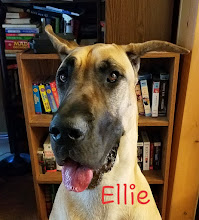One advantage of having a dog with no dewclaws is that it means two fewer nails to trim - and although my crew is good about that, it still saves a bit of time on each dog.
Kinsey and her sister Aeryn had their dewclaws removed shortly after they were born, so I really wasn't concerned about having the dewclaws removed from Kinsey's pups when they were two days old.
However, since then (that litter turned 3 last summer) I've learned about some of the cons of dewclaw removal in performance dogs. Chris Zink, DVM is a veterinarian and consultant about canine sports medicine and she is a big proponent of leaving front dewclaws where they are.
She says they are important to prevent torque on the foreleg, and to maintain the integrity of the carpal joint. Specifically in her article With a Flick of the Wrist she says: "In the canter, there is a moment during each stride when the dog's accessory carpal pad (on the back of the carpus) of the lead front leg touches the ground and the rear legs and other front leg swing forward to prepare for the next stride. At this point, the dewclaw is in contact with the ground and if the dog turns, the dewclaw can dig in for extra traction to prevent unnecessary torque on the front leg. Without the gripping action of the dog's 'thumbs’ there is more stress on the ligaments of the carpus. This may cause the ligaments to stretch and tear over time, resulting in joint laxity and ultimately, arthritis."
I have actually been a little skeptical about this. Of course, I understand that at speed and/or when turning, a dog's pasterns extend just like a horse's do and will drop low to the ground to absorb shock. But I photograph and film my dogs a lot, and have never seen anything near to the degree of pastern extension she's talking about. The thought of that dewclaw actually touching the ground seems sort of unlikely.
And then I ran across this photo from a bunch I took of Kinsey at an agility trial a few months ago:
 It's not a great photo and I was about to discard it when I took another look:
It's not a great photo and I was about to discard it when I took another look: The red circle is about where her dewclaw would be if she had one. And, yes, it does look like it would be contacting the ground if it were there.
The red circle is about where her dewclaw would be if she had one. And, yes, it does look like it would be contacting the ground if it were there.I'm still not totally convinced... "touching" the ground isn't the same thing as "digging in" and it doesn't look to me like her pastern is THAT extended.
But it sure gives me something to think about.









6 comments:
Those pictures always gross me out.... I can't believe the joint flexes that much, but it does. I'm not sure if the dewclaw reduces torque either. They seem to get ripped off if there is too much torque, so I'm not sure how much good that is. I have greyhounds with and without and never noticed a difference either.
Jen
It's amazing, isn't it? I mean, you couldn't begin to just bend the joint back that far by hand, no matter how relaxed the dog was.
Exactly! In fact, I think I would hurt my dog if I tried. Makes you wonder how much pressure they are putting on their legs when they are in motion.
Jen
Wow, that really is something in the photo. It's like when someone takes their thumb and bends it backwards far enough to touch their forearm.
I still like the less nails to clip benefit, but you have me thinking :)
Just found your blog- interesting topic. I would tend to argue with the reduction of torque by leaving dewclaws intact. Being there is little to no muscle mass within the dewclaw for support on most breeds, it is pretty much reduced to hanging, flopping appendage. I cannot see anyway possible it could "dig in" to provide any support.
I do prefer them to be removed in that they are IMO useless and I did not notice anything untoward in my litter I had done. But it is a personal choice and I think that is what should be supported.
Post a Comment